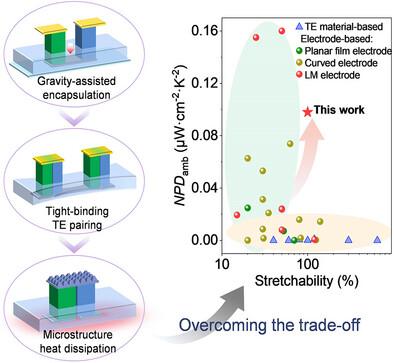Mechanical-Thermal Co-Design of Flexible Thermoelectric Devices with Solid-Liquid Electrodes for Enhanced Stretchability and Power Generation
IF 26
1区 材料科学
Q1 CHEMISTRY, PHYSICAL
引用次数: 0
Abstract
The trade-off between stretchability and power generation performance of flexible thermoelectric devices (FTEDs) hinders their practical applications in self-powered wearable electronics. Herein, a novel mechanical-thermal co-design strategy is proposed based on a solid-liquid electrode configuration to address this critical issue. This approach introduces a gravity-assisted controllable encapsulation method that enables thin-layer elastic confinement of liquid metal electrodes, simultaneously minimizing parasitic thermal resistance and achieving exceptional stretchability. Additionally, a tight-binding arrangement of thermoelectric pairs mitigates interfacial stress concentration during mechanical deformation to significantly improve stretchability, while microstructured solid electrodes enhance heat dissipation to boost output power. The optimized device achieves over 100% stretchability (device resistance change does not exceed 10%) and a normalized output power density of 0.098 µW cm−2 K−2 under natural convection conditions without external heat sinks, with excellent stability maintained after over 10 000 cycles under large tensile and bending strains. As a proof of concept, the efficient applications of the FTEDs are demonstrated in harvesting heat from curved surfaces in various scenarios and powering LED bulbs. This work presents a breakthrough in achieving both high power generation performance and high stretchability in FTEDs, providing a new pathway for developing devices to harvest heat from highly deformable surfaces.

基于固液电极的柔性热电器件的机械-热协同设计,以提高可拉伸性和发电能力
柔性热电器件(FTEDs)的可拉伸性和发电性能之间的权衡阻碍了其在自供电可穿戴电子产品中的实际应用。本文提出了一种基于固液电极结构的机械-热协同设计策略来解决这一关键问题。该方法引入了一种重力辅助可控封装方法,可以实现液态金属电极的薄层弹性约束,同时最大限度地减少寄生热阻并实现卓越的拉伸性。此外,热电对紧密结合的排列减轻了机械变形过程中的界面应力集中,显著提高了拉伸性,而微结构固体电极增强了散热,提高了输出功率。优化后的器件在自然对流条件下实现了超过100%的拉伸性(器件电阻变化不超过10%),在没有外部散热器的情况下,归一化输出功率密度为0.098µW cm−2 K−2,在大拉伸和弯曲应变下超过10,000次循环后保持了优异的稳定性。作为概念验证,FTEDs在各种场景中从曲面收集热量和为LED灯泡供电方面的有效应用得到了证明。这项工作在实现fted的高发电性能和高拉伸性能方面取得了突破,为开发从高度可变形表面收集热量的设备提供了新的途径。
本文章由计算机程序翻译,如有差异,请以英文原文为准。
求助全文
约1分钟内获得全文
求助全文
来源期刊

Advanced Energy Materials
CHEMISTRY, PHYSICAL-ENERGY & FUELS
CiteScore
41.90
自引率
4.00%
发文量
889
审稿时长
1.4 months
期刊介绍:
Established in 2011, Advanced Energy Materials is an international, interdisciplinary, English-language journal that focuses on materials used in energy harvesting, conversion, and storage. It is regarded as a top-quality journal alongside Advanced Materials, Advanced Functional Materials, and Small.
With a 2022 Impact Factor of 27.8, Advanced Energy Materials is considered a prime source for the best energy-related research. The journal covers a wide range of topics in energy-related research, including organic and inorganic photovoltaics, batteries and supercapacitors, fuel cells, hydrogen generation and storage, thermoelectrics, water splitting and photocatalysis, solar fuels and thermosolar power, magnetocalorics, and piezoelectronics.
The readership of Advanced Energy Materials includes materials scientists, chemists, physicists, and engineers in both academia and industry. The journal is indexed in various databases and collections, such as Advanced Technologies & Aerospace Database, FIZ Karlsruhe, INSPEC (IET), Science Citation Index Expanded, Technology Collection, and Web of Science, among others.
 求助内容:
求助内容: 应助结果提醒方式:
应助结果提醒方式:


